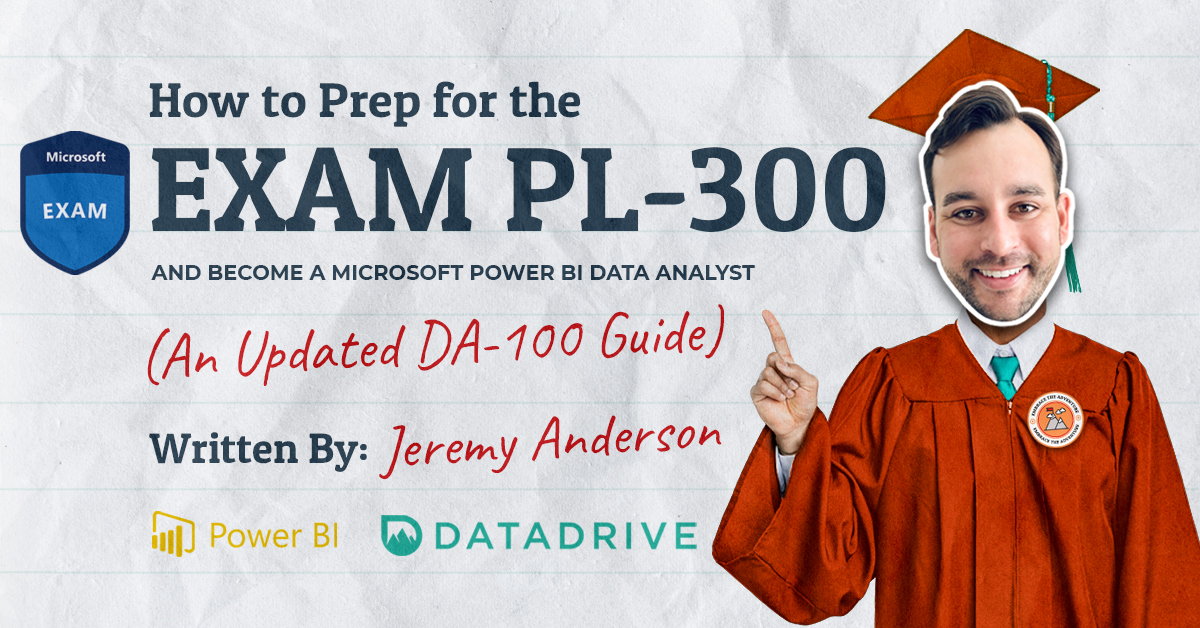Tableau Conference 2025 | Know Before You Go
If you’re a data enthusiast, analytics professional, or just someone curious about Tableau’s latest innovations, the Tableau Conference 2025 is your...
4 min read
 Jeremy Anderson
Mar 9, 2022
Jeremy Anderson
Mar 9, 2022

Editor’s Note: This blog was originally published on Sep 29, 2021 and has been updated to reflect the latest updates to Microsoft’s Data Analyst Certification.
On February 28, 2022, Microsoft released a new data analyst certification called Microsoft Certified: Power BI Data Analyst Associate. This new certification replaces the Microsoft Certified: Data Analyst Associate certification.
In this blog, I will equip you with a game plan to help you pass the Exam PL-300 and earn that Power BI certification! I will also share insights from my experience passing the Exam DA-100, as both Microsoft exams are similar.
For a quick reference, here is a breakdown of the change:

Passing the PL-300 exam is your ticket to earning the title of Microsoft Certified: Power BI Data Analyst Associate. This Power BI certification is aimed at equipping analysts with the skill set to leverage and deploy Power BI at scale across organizations. Earning this Microsoft certification is a great option for someone seeking to advance their career as a data analyst.
The cost is $165 USD and you have 100 minutes to answer between 40-60 questions. The types of questions include multiple-choice, true/false, drag and drop, list builds, and case studies. The exam is proctored by Pearson VUE and you can take it online in the comfort of your own home or at a local testing center.
As far as content, the visual below breaks down the skills measured. Be sure to review the skills guide for details on what each skill entails. To pass the exam, you must score at least 700 out of 1,000 points (70%). Finally, the certification is valid for one year.
Official PL-300 Exam Resources:
When I decided to pursue the Data Analyst Associate certification, I had been working with Power BI for about two years. As an analyst in a previous role, I had developed several reports and maintained an app for a sales and marketing department. I knew that I had a solid baseline, but would need to fill in some gaps. I read through the skills outline to give me a quick sense of what level I was at and what I needed to work on.
If you have been working with Power BI for several months or years, you likely have a great foundation and can focus on filling in the gaps. Reading through the skills outline will help you know where to focus your exam preparation.
If you are brand new to Power BI, give yourself some time to learn the basics before starting some of the heavy lifting for the exam prep. If you are wondering where to get started with learning Power BI, check out Guy in Cube’s video Create your first Power BI report (2021).
Because getting experience with Power BI is so valuable, look for ways to start using it day-to-day. Here are some ideas for getting some practical experience:
After reading through the skills outline, I identified the areas that I needed to work on. I determined that I needed a combination of Microsoft guided learning, plus a formal course.
Microsoft offers six free Learning Paths, available online. This is a great option for self-starters. A big upside to the Learning Paths are the built-in labs, which take you to a virtual environment where you conduct report development within Power BI. I spent about one month working on the Guided Learning paths. Note that Microsoft also offers paid, instructor-led training.
For the formal course component, I enrolled in the Microsoft Power BI Certification: PL-300 Exam Prep course offered on Udemy by Aaron Parry from Maven Analytics. You can also sign up for this course on the Maven Analytics platform where they have additional training available. This was a fantastic course with so much rich content. Not only do you cover the concepts in a video lecture format, you also complete a hands-on project where you create a Power BI report and deploy it to the service. The course also offers a practice exam, which is a great way to gauge if you are ready for the real thing. I spent about one month working on this course.
My final course project:
Once you evaluate your starting point and craft your learning plan, now it is time to break it down and work through it. The biggest thing you can do is to stay consistent in your learning. Because there are a large number of skills evaluated (over 80!), it’s important to be patient and break things down in small chunks.
Here’s a sample 10-week learning plan:
Weeks 1-5: Microsoft Learning Paths (scroll down to the Learning Paths section)
Weeks 6-10: Prep Course & Practice Exam
You can certainly go faster or slower depending on your schedule!
Taking a practice exam is a great way to determine your readiness. Flag the questions that you get wrong and focus on those areas during your final preparation.

The big question is ‘When do I know I’m ready to take the exam?’ For me, I knew I was ready to schedule the exam once I passed a practice test and felt relatively comfortable with all of the major domain areas.
On exam day, you should plan for a two-hour block, as you will check-in approximately 20 minutes before the exam and have 100 minutes to complete it. Once you schedule the exam, you can then plan for the logistics and familiarize yourself with the rules. For example, you will need to present a photo ID and take the exam in a quiet room if you go with the virtual option.
Once it’s exam time, relax, breathe, and good luck!
Official PL-300 Exam Resources:
PL-300 Exam Prep Course:
Getting Started with Power BI:
-2.gif)
If you’re a data enthusiast, analytics professional, or just someone curious about Tableau’s latest innovations, the Tableau Conference 2025 is your...

Tableau Plus is the new premium offering from Tableau, a leading data visualization and business intelligence platform. It builds upon the...

If you've spent any time working with Tableau, you've likely encountered the dreaded "Cannot Mix Aggregate and Non-Aggregate Arguments" error. It's a...